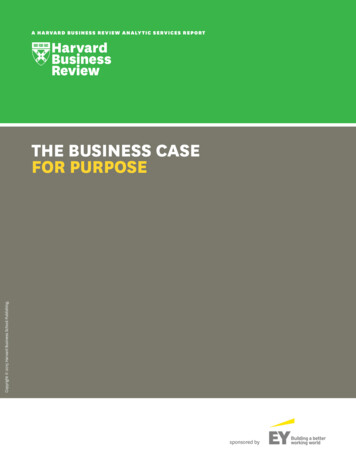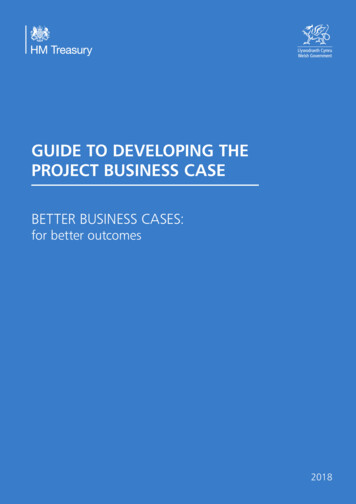
Transcription
A HARVARD BUS I N E S S R E V I E W A N A LY TI C SERVICES REPO RTCopyright 2015 Harvard Business School Publishing.THE BUSINESS CASEFOR PURPOSEsponsored by
SPONSOR PERSPECTIVEAround the world, the businessenvironment is in a permanentstate of disruption. Todaymore than ever, companies aresearching for a new genetic codethat will help them continuouslyevolve—to survive and to thrive.The EY Beacon Institute waslaunched in response to this transformation imperative.A community of global executives, entrepreneurs,academics, and thought leaders, the Beacon Instituteis advancing the transformation of the working world,redefining what it means to be a successful company inthe 21st century.A tie that binds our community is a shared understandingthat there is a new leading edge: Those companies able toharness the power of purpose to drive performance andprofitability enjoy a distinct competitive advantage.Laden with many meanings, the core insight about thisnotion of “purpose” is that meaning matters—not just in anabstract sense, but in terms of today’s business metrics.In the interest of advancing the science of purpose, EYBeacon Institute teamed with Harvard Business ReviewAnalytic Services, surveying global business executivesabout the extent to which purpose is utilized by theirorganizations—and, importantly, the impact that it hasupon their ability to grow, innovate, and transform.We found a very high level of consensus among theseexecutives that purpose matters, and a widespreadbelief that it has positive effects on key performancedrivers. The survey also demonstrates that companieswho clearly articulate their purpose enjoy higher growthrates and higher levels of success in transformation andinnovation initiatives.This did not surprise us. At EY, when we began ourpurpose-led transformation to “build a better workingworld,” we experienced firsthand the same benefits andbarriers explored here. And we have seen these as wellwhen supporting our clients’ transformation journeys.Given the strong sentiment that purpose is important andthe clear benefits it seems to accrue, it is curious thatpurpose is utilized by only a minority of companies asa driver of strategy and decision-making. As the surveyfindings suggest, this is due not only to external issues,such as short-term pressures from investors, but also tointernal issues such as insufficient leadership commitmentand misaligned performance metrics.This raises many interesting questions, not the least ofwhich is why and particularly how some organizationsare better able to strategically integrate and capitalize onpurpose than others. We believe that better questionslead to better answers. With our community of globalleaders, Beacon will continue to advance research, sharestories, and amplify a growing dialogue on how businessesare redefining success to create sustainable value.We invite you to connect with us at ey.com/beacon—andto join the movement of those on the leading edgeof transforming the working world.Valerie KellerGlobal Lead, EY Beacon Institute
THE BUSINESS CASEFOR PURPOSEBusinesses face an accelerated pace of change as digitalization, disruptive business, and rapidlychanging consumer expectations reshape their world. At the same time, the demands of a newgeneration of employees for meaning in their work, the declining levels of trust in companies,and a wider debate about the role business can or should play in society are reshaping expectations of organizations.Over the past few years, a growing number of corporate leaders and experts have spoken outabout how a strong shared sense of purpose can help companies meet these new challenges andtransform their organizations. In order to understand why, and more importantly, how, companies are employing purpose to guide and lend impetus to their transformations, HarvardBusiness Review Analytic Services conducted a survey sponsored by the EY Beacon Institute.The global survey of 474 executives found that although there is near-unanimity in the businesscommunity about the value of purpose in driving performance, less than half of the executivessurveyed said their company had actually articulated a strong sense of purpose and used it as away to make decisions and strengthen motivation. Only a few companies appear to have embedded their purpose to a point where they have reaped its full potential. figure 1But in those organizations where purpose had become a driver of strategy and decision-making,executives reported a greater ability to deliver revenue growth and drive successful innovationand ongoing transformation.THE RESULTSThe survey defined organizational purpose as “an aspirational reason for being which inspiresand provides a call to action for an organization and its partners and stakeholders and providesbenefit to local and global society.”And although 90 percent of executives surveyed said their company understands the importanceof such purpose, only 46 percent said it informs their strategic and operational decision-making.This survey suggests that purpose is a powerful though underutilized tool: Most executives believe purpose matters. Eighty-nine percent of executives surveyed said astrong sense of collective purpose drives employee satisfaction; 84 percent said it can affectan organization’s ability to transform, and 80 percent said it helps increase customer loyalty. but only a minority said their company currently runs in a purpose-driven way. Forty-sixpercent said their company has a strong sense of purpose while another 44 percent said theircompany is trying to develop one.TH E BUS INES S CAS E FO R P U R P O S E1
FIGURE 1ORGANIZATIONAL PURPOSE IN THEORY AND IN REALITYPercentage of respondents who agreed with each of the following statements.Top box scores 8-10, where 10 strongly agree.89An organization with shared purpose will have employee satisfaction85I’m more likely to recommend a company with strong purpose to others84Our business transformation efforts will have greater success if integrated with purpose84An organization that has shared purpose will be more successful in transformation efforts81Purpose-driven firms deliver higher-quality products/services80An organization with shared purpose will have greater customer loyalty50Our organization’s strategy is reflective of our sense of purpose46My organization has a strong shared sense of purpose41There is a disconnect between our senior executives and our employees over purpose38Our staff have clear understanding of organizational purpose and commitment to core values/beliefs37Our business model and operations are well-aligned with our purpose PURPOSE IN THEORY PURPOSE IN REALITYBASE: ALL RESPONDENTS. N 4742H A RVA R D BU S I N E S S R E VI E W A N A LYT I C S E RV IC ES
Companies with a strong sense of purpose are able to transform and innovate better. Thoseexecutives who treat purpose as a core driver of strategy and decision-making reported greaterability to drive successful innovation and transformational change and deliver consistentrevenue growth: 53 percent of executives who said their company has a strong sense of purposesaid their organization is successful with innovation and transformation efforts, compared with31 percent of those who are trying to articulate a sense of purpose and 19 percent of the companies who have not thought about it at all. figure 7Given the high level of consensus around purpose and so many good reported results, whyaren’t more companies motivating employees, attracting customers, and aligning supplierswith a strong purpose? The survey found the problem may lie at the top: the executives surveyed said that companies need to do a better job embedding their purpose in the organization, particularly in leadership development and training, in employee performance metricsand rewards, and in operations.WHY PURPOSE MATTERSThe survey found that most companies in the survey fall into three categories with respect topurpose: prioritizers, companies that already have a clearly articulated and understood purpose (39 percent); developers, companies that do not yet have a clearly articulated purpose butare working to develop one (48 percent); and laggards, companies that have not yet begun todevelop or even think about purpose (13 percent). figure 2FIGURE 2MORE THAN ONE-THIRD ARE PRIORITIZERSPercentage who said the following statement best applies to their organization.LaggardsPrioritizers13%Purpose clearly articulated and understood39%48Purpose understood by some areas better than othersPurpose not well understood or communicated%DevelopersBASE: ALL SAYING ORGANIZATION HAS/IS WORKING ON A STATED OR IMPLIED PURPOSE. N 431TH E BUS INES S CAS E FO R P U R P O S E3
FIGURE 3PRIORITIZERS HAD AN EDGE ON REVENUE IN THE PAST 3 YEARSPercentage who indicated how their revenue has changed in the past three years. FLAT/DECLINE 0-10% GROWTH 10% ardsBASE: ALL SAYING ORGANIZATION HAS/IS WORKING ON A STATED OR IMPLIED PURPOSE. N 431WHY PURPOSE BRINGS MEANINGManagement thinkers agree that conceptions about corporate meaningare evolving rapidly.“There is an increasing awareness that the purpose of a company has to be beyondshareholder value, and that this is not something that will cost your business butsomething that will enhance your business,” said Michael Beer, Cahners-Rabb Professorof Business Administration, Emeritus, at Harvard Business School and a director of theCenter for Higher Ambition Leadership.Much of the discussion about purpose suggests that companies perform better if theyhave a clear sense of purpose. Purpose-driven companies make more money, havemore engaged employees and more loyal customers, and are even better at innovationand transformational change. It seems to be easier to win the game when you careabout the game.“The sense of being part of something greater than yourself can lead to high levels ofengagement, high levels of creativity, and the willingness to partner across functionaland product boundaries within a company, which are hugely powerful,” said RebeccaHenderson, the John and Natty McArthur University Professor at Harvard BusinessSchool. “Once they’re past a certain financial threshold, many people are as motivatedby intrinsic meaning and the sense that they are contributing to something worthwhile asmuch as they are by financial returns or status.”4H A RVA R D BU S I N E S S R E VI E W A N A LYT I C S E RV IC ES
“ Purpose is cer tainly not just a marketing issue orpositioning of your brand image. Purpose shouldimpact every aspect of the firm.” —Raj SisodiaPRIORITIZERS’ PERFORMANCE ADVANTAGEPrioritizers reported performing better than either developers or laggards across a number ofbusiness activities. A clearly articulated purpose appears to yield many important benefits, butperhaps the easiest to quantify and the most persuasive is that prioritizing companies performbetter: 58 percent of prioritizers said they experienced growth of 10 percent or more over the pastthree years, compared with 51 percent of the developers and 42 percent of the laggards. figure 3Purpose—or the lack of shared understanding of purpose—seems to have a direct impact on thebottom line. Forty-two percent of laggards reported flat or declining revenue over the past threeyears, compared with 19 percent of developers and only 15 percent of prioritizers.STRATEGIC PURPOSEA similar pattern emerged around the ability to innovate and transform. More of the self-identified prioritizers said they had successfully completed a major initiative in the past three years,including expanding geographically, changing their business model and/or operations, completing a merger, and launching a new product. New markets were a particular area of strength forprioritizers: 66 percent of that group reported expanding geographically, while 44 percent ofdevelopers and 48 percent of laggards reported success in that area.Only when it came to expanding into additional market segments did the laggards lead theprioritizers, for reasons that are unclear but may merit further study. figure 4The prioritizers saw a clear link between a widely understood sense of purpose and the abilityto innovate and transform. Forty-nine percent said their organization had made a change instrategy development over the past three years based on purpose, and a third said purpose hadpropelled shifts in the business model as well as product and service development.Experts say that purpose streamlines the way decisions are made. “It’s an inside-out strategyrather than outside-in: you don’t just look at where the opportunities are and where you couldmake a lot of money as a way to decide where you ought to be. You decide where you want to bestrategically, based on what you want to do,” said Michael Beer, the Cahners-Rabb Professor ofBusiness Administration, Emeritus, at Harvard Business School and a director of the Center forHigher Ambition Leadership.Interestingly, developers were more likely to make gains in branding than companies thatalready had a highly developed sense of purpose. Forty percent of developers said their purposeorientation had helped them drive changes to their brand over the past three years, comparedwith 32 percent of prioritizers. Purpose also helped the developers with their strategy (44 percent) and their new business development (33 percent). figure 5TH E BUS INES S CAS E FO R P U R P O S E5
FIGURE 4SUCCESSFUL INITIATIVESPercentage who indicated how successful their organization was in undertaking thefollowing initiatives. Top box scores 8-10, where 10 extremely successful.44Expanded geographicallyChanged top leadership6648584537573740Been part of an acquisition/mergerLaunched new products563633543658Expanded into new market segments (i.e., new customer demographics)523316Engaged in a major transformation initiative (e.g., changes in business model and/or operations)264943Launc
THE BUSINESS CASE FOR PURPOSE 1 Businesses face an accelerated pace of change as digitalization, disruptive business, and rapidly changing consumer expectations reshape their world.











